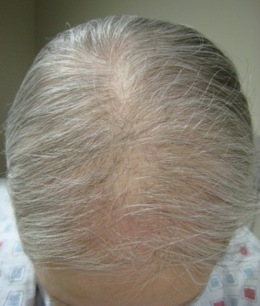The prevalence of pattern hair loss may be as high as 98% and as low as 40%, depending on the study definitions.[1]Norwood OT. Male pattern baldness: classification and incidence. South Med J. 1975 Nov;68(11):1359-65.
http://www.ncbi.nlm.nih.gov/pubmed/1188424?tool=bestpractice.com
[3]Stough D, Stenn K, Haber R, et al. Psychological effects, pathophysiology, and management of androgenic alopecia in men. Mayo Clin Proc. 2005 Oct;80(10):1316-22.
http://www.ncbi.nlm.nih.gov/pubmed/16212145?tool=bestpractice.com
[4]Gan DC, Sinclair RD. Prevalence of male and female pattern hair loss in Maryborough. J Investig Dermatol Symp Proc. 2005 Dec;10(3):184-9.
http://www.jidsponline.org/article/S0022-202X(15)52584-0/abstract
http://www.ncbi.nlm.nih.gov/pubmed/16382660?tool=bestpractice.com
[5]Rhodes T, Girman CJ, Savin RC, et al. Prevalence of male pattern hair loss in 18-49 year old men. Dermatol Surg. 1998 Dec;24(12):1330-2.
http://www.ncbi.nlm.nih.gov/pubmed/9865198?tool=bestpractice.com
Historically, male- and female-pattern hair loss has been significantly underestimated by the exclusion of the early stages of hair loss. In men, the age of onset usually is between 20 and 25 years, and prevalence and severity of disease increase with age. In general, 30% of white people are affected by age 30 years, 50% by age 50 years, and 80% by age 70 years. The global incidence varies among ethnic groups with the greatest incidence in white people, followed by Asians, African Americans, and Native Americans.[4]Gan DC, Sinclair RD. Prevalence of male and female pattern hair loss in Maryborough. J Investig Dermatol Symp Proc. 2005 Dec;10(3):184-9.
http://www.jidsponline.org/article/S0022-202X(15)52584-0/abstract
http://www.ncbi.nlm.nih.gov/pubmed/16382660?tool=bestpractice.com
[5]Rhodes T, Girman CJ, Savin RC, et al. Prevalence of male pattern hair loss in 18-49 year old men. Dermatol Surg. 1998 Dec;24(12):1330-2.
http://www.ncbi.nlm.nih.gov/pubmed/9865198?tool=bestpractice.com
[6]Otberg N, Finner AM, Shapiro J. Androgenetic alopecia. Endocrinol Metabol Clin N Am. 2007 Jun;36(2):379-98.
http://www.ncbi.nlm.nih.gov/pubmed/17543725?tool=bestpractice.com
In women, the onset of hair loss is usually before 40 years, and over 10% of premenopausal women have some evidence of pattern hair loss.[2]Ludwig E. Classification of the types of androgenetic alopecia (common baldness) occurring in the female sex. Br J Dermatol. 1977 Sep;97(3):247-54.
http://www.ncbi.nlm.nih.gov/pubmed/921894?tool=bestpractice.com
[7]Starace M, Orlando G, Alessandrini A, et al. Female androgenetic alopecia: an update on diagnosis and management. Am J Clin Dermatol. 2020 Feb;21(1):69-84.
http://www.ncbi.nlm.nih.gov/pubmed/31677111?tool=bestpractice.com
[8]Venning VA, Dawber RP. Patterned androgenic alopecia in women. J Am Acad Dermatol. 1988 May;18(5 Pt 1):1073-7.
http://www.ncbi.nlm.nih.gov/pubmed/3385027?tool=bestpractice.com
[9]Birch MP, Lalla SC, Messenger AG. Female pattern hair loss. Clin Exp. Dermatol. 2002 Jul;27(5):383-88.
http://www.ncbi.nlm.nih.gov/pubmed/12190638?tool=bestpractice.com
[Figure caption and citation for the preceding image starts]: Female-pattern androgenetic alopeciaFrom the collection of Robert Haber, MD [Citation ends]. However, the incidence increases in women around the time of menopause and may affect up to 56% of women over the age of 70 years.[7]Starace M, Orlando G, Alessandrini A, et al. Female androgenetic alopecia: an update on diagnosis and management. Am J Clin Dermatol. 2020 Feb;21(1):69-84.
http://www.ncbi.nlm.nih.gov/pubmed/31677111?tool=bestpractice.com
However, the incidence increases in women around the time of menopause and may affect up to 56% of women over the age of 70 years.[7]Starace M, Orlando G, Alessandrini A, et al. Female androgenetic alopecia: an update on diagnosis and management. Am J Clin Dermatol. 2020 Feb;21(1):69-84.
http://www.ncbi.nlm.nih.gov/pubmed/31677111?tool=bestpractice.com
 However, the incidence increases in women around the time of menopause and may affect up to 56% of women over the age of 70 years.[7]
However, the incidence increases in women around the time of menopause and may affect up to 56% of women over the age of 70 years.[7]